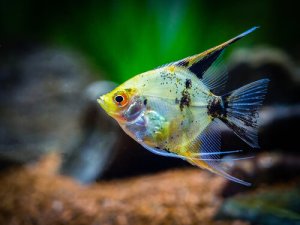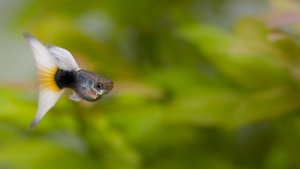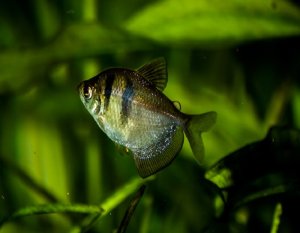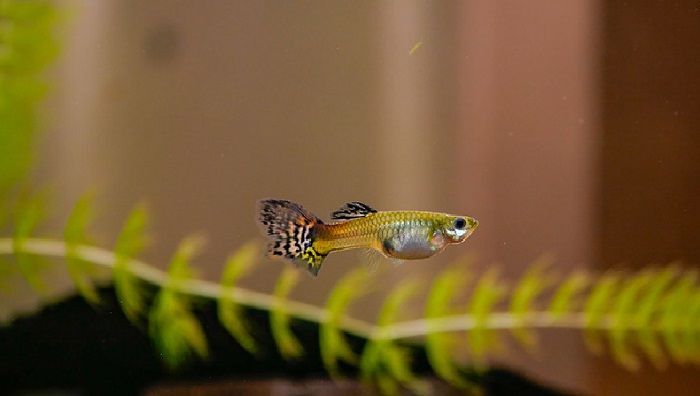
Guppies are an extremely popular freshwater fish species in the Aquarium that are copious and eager breeders. The Guppy females are one of a few freshwater Aquarium fish species that give live birth to their young.
Whether you are breeding Guppies intentionally for certain colors or species, or one or more of your females have “accidentally” become pregnant, it is vital to take proper precautions to ensure both the female and her young are safe and taken care of. There are some actions to be taken to ensure a safe and healthy birthing process, however firstly it is necessary to understand a bit more about the Guppy and its breeding methods.
Guppy Species Information
Also known as the Millionfish or Rainbow Fish, the Guppy (Poecilia reticulata), is a freshwater aquarium fish that is the most widely spread and popular in the world. Guppies initially originated from Northeast South America and form part of the Live-bearing fish species, because they give live birth to their young and do not lay eggs as with most fish species.
Guppies are popular because of their intriguing and many color variations, as well as their superior adaptability to various water conditions and environments. Male Guppies are always smaller with more vibrant colors, and extravagant finnage than females, who appear larger and less colorful, which is referred to as Sexual Dimorphism.
According to some field studies performed, it is revealed that Guppies have colonized almost all available water bodies that became accessible to them in nature, some including freshwater streams, and even coastal water. Therefore, they are tolerant to both freshwater and brackish water, and more accepting of different climates and water temperatures. Like their close relatives the Molly fish, Guppies can easily survive in saltwater aquariums as well as freshwater aquariums.
Guppy Physical Appearance And Variations
There is much to be said about the Guppy, with so many Color and species Variations, and when selectively breeding it is crucial to ensure that you have Guppies that are the right species and age.
Size And Lifespan
The size of Guppies may vary, however, according to most resources, males will typically reach sizes of between 1.5–3.5 cm (0.6–1.4 in) long, and females between 3–6 cm (1.2–2.4 in) long. Most Guppies will only reach an age of around 2 years in captivity, though in some extreme cases, they have been known to live longer. Guppies become mature and able to produce offspring between 10 – and 20 weeks of age in females, and males mature around 7 weeks of age.
Color Strains
Wild Guppies exhibit grayish colors in females, whereas the males are gray with slight splashes of spots, stripes, or other patterns of color. Did you know that the color patterns exhibited by males are ideally due to the number of thyroid hormones that they contain?
Through the years many different Guppy strains have been bred with selective breeding methods. They are mostly characterized by their different colors, patterns, and the shapes and sizes of their fins. There are similar a variety of skin pattern types such as the snakeskin modifications.
Guppy Types According To Species
There are mainly three different Guppy types according to their species;
- Fancy Guppies – A wider available and more hardy species with magnificent colors and finnage, usually referred to as “Rainbowfish” or “Millionfish”.
- Swamp Guppies – Also referred to as “Scarlet Livebearers”. They are usually a rich red or orange color and prefer more alkaline and brackish water conditions.
- Endler Guppies or Livebearers – Discovered by professor John Endler they usually have more metallic or silver color tones, which may change depending on the environment they are kept in.
Not to go into too much detail Guppies are similarly divided into categories of Tail Shape, Body Patterns, and colors, here is a quick overview that can be further researched for selective breeding purposes;
- Tail Shapes – Fantail, Veiltail, Triangle or Delta Tail, sword and Double Swordtail, Scarf or Flag Tail, Top Swordtail, Bottom Swordtail, Lyretail, Speartail, Roundtail, Pintail or Needletail, Halfmoontail, and Cofertail.
- Body Patterns – Cobra, Tuxedo, Snakeskin.
- Tail Color Patterns – Lace, Glass, Mosaic, Leopard.
- Colors – Albino, White, Red, Black, Blue, Metallic Blue, Japanese Blue, Green, Yellow, Purple, Bronze Gold. Similarly, all these colors can be found with half of the Guppy Black and the other half a color. Then there are likewise Pastel, Metallic, Koi, Panda, Moscow, Bi-Colored, Multi-Colored, Dragonhead, and Solid color Guppies.
Formerly there is what is known as the Dumbo Ear Guppy, which has larger pectoral fins, that is quite popular.
General Care Tips
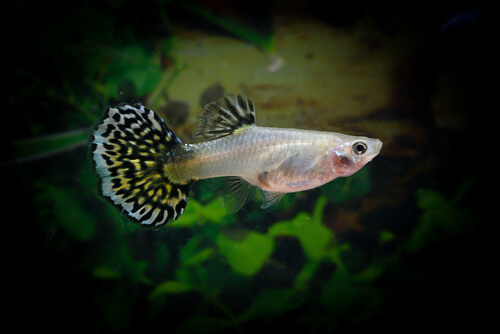
One thing that is adored about Guppies is the fact that they are so easy to care for, following the correct care guidelines. They are ideal for beginners and experienced aquarists or even breeders alike. It is vital to create a comfortable and suitable living environment along with proper care for Guppies in general, and especially for breeding, and caring for pregnant females. The care tips given below are basic and you can follow a care guide for more details:
1. Aquarium – For two to three Guppies a 20-gallon tank is advised with an additional 5 gallons per extra Guppy or other fish species added. Guppies prefer water temperatures of around 78–82°F (25.5 – 27.8°C), and need a tank light or indirect sunlight, indicating day and night. They thrive in water conditions with a pH of between 6.5 and 8.5 and prefer slightly brackish water.
Their tank can be decorated with fine gravel or sand substrate, toys for enrichment, and hiding spaces, such as caves, Rocks, Shipwrecks, and Driftwood. Synthetic or Live, rooted, or floating plants are ideal. Keep in Mind Live plants help to clean water and provide extra oxygen.
2. Feeding – Guppies are omnivores, and slow eaters preferring a greater variety of foods. They can be fed meat-based foods such as Brine Shrimp, daphnia, insect larvae, Bloodworms, cooked beef mince or egg yolk, and plant-based foods consisting of green vegetables that have been balanced. A staple of quality pellets or flakes must be fed initially.
3. Behaviour And Temperament – Guppies are known as being more “individual” having personalities of their own. However, in general, they are sociable and peaceful. Guppies are extremely eager breeders, and it is well advised to always have a ratio of three females per male to prevent females from becoming stressed with constant pursuits by males.
4. Suitable Tank Mates – In the event of a communal tank, it is crucial to ensure that suitable tank mates are chosen, with similar water parameter requirements, and a peaceful nature. A few suitable species include; Pygmy or Cory Catfish and Kuhli Loaches as bottom feeders, Platies, Neon, Ember or Black Tetras, Mollies, and certain types of snails or shrimps.
5. Common Health Issues – Though quite hardy, Guppies are prone to the typical freshwater fish health conditions:
- Ich – A parasite causing white spots on the fins and skin of your Guppies.
- Fin or Tail Rot – A bacterial infection as a result of physical damage or ammonia burns from dirty water.
- Swim Bladder Infection – The infection may be fungal or bacterial, which will determine the course of treatment. You will notice your Guppy floating or struggling to stay upright.
Most of these conditions are treated using a quarantine period in clean water conditions, with medication for the specific ailment. To prevent disease, always quarantine any new plants or fish, and keep water conditions at clean, and peak levels.
Breeding Guppies
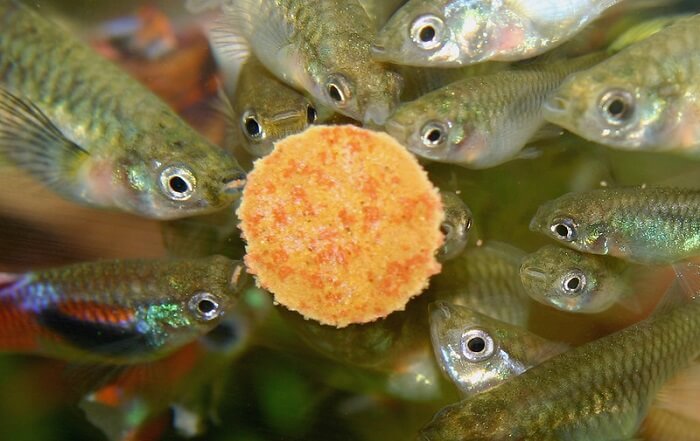
As mentioned, breeding Guppies is quite an easy endeavor as they are prolific breeders that will breed regardless of whether you want them to or not. Though it must be said they have cannibalistic tendencies towards their young, it is vital to separate the fry from adult Guppies, and other fish species in a communal tank, that may have similar tendencies. Guppies give live birth, and to ensure a healthy batch of fry and a healthy postnatal mother, some extra care is required, which will be conferred further on.
Determining Gender
Before considering breeding, it is necessary to start with a proper male and female ratio of three females per single male. Both males and females need to be sexually mature, and it is quite easy to determine genders.
- Females – Mature females tend to be larger, duller in color, with short tails and fins. Juvenile females have what is called a gravid spot (a dark pigmented area in the anal spot), which is not visible in males.
- Males – Mature males will be smaller, with brighter colors and larger fins than females. Juvenile males have a thickened anal fin, no gravid spot, and more vibrant colors even when young.
Juvenile males need to be kept with young females to learn proper sexual behavior, as males alone kept together may exhibit homosexual behavior.
Creating A Breeding Tank And Mating
Now that the male and female suitors have been selected in the correct color variations of choice, it is important to provide the proper care steps for the successful breeding of guppies:
- Select your breeding pairs according to color and tail shape of preference.
- Create a separate 10 to 20 gallon breeding tank with temperatures of around 77°F and 79°F. (25 ̊C – 27 ̊C) that is ideal, and a water pH of 7.0 to 8.0, not more or less.
- Add low floating plants, and high covering plants, along with spawning moss, Java Moss, or rooted plants that are dense for young fry to hide in. No substrate is required for easier cleaning.
- Place the Male and female Guppies in your breeding tank, providing them with more regular feeds in smaller amounts, consisting of mostly protein-based foods.
- Now it is all up to nature taking its course for Guppies to mate.
How To Know When Your Guppy Is Pregnant
Once it is certain that the female, or females are pregnant, the males can be returned to their original aquarium. Females will display a much larger and darkened gravid spot on their abdomen if they are pregnant. Similarly, their bellies will become larger and rounder as the pregnancy progresses. Keep in mind there may similarly be a slim chance that your female guppy can be infertile.
According to various resources, it is noted that the average gestation period for guppies is 22 to 26 days, though there have been cases where it took 21 or up to 20 days. Much of the gestation period depends on water cleanliness and temperatures.
How To Know When Your Guppy Is About To Give Birth
It is crucial to provide a safe and comfortable environment for both the mother and baby guppies (fry) as soon as signs of birth are impending. A pregnant Guppy about to give birth will show the following signs;
- Hiding – Guppies are generally social and outgoing, though females who are close to giving birth will start to hide or look for a safe and secluded area to give birth.
- Loss of Appetite – Because giving birth is quite stressful for Guppies, the female will be reluctant to eat, in which case more of her favorite protein-rich foods should be provided.
- Belly Form – A couple of days before the female gives birth, her belly will have a more angular shape, than the regular round shape.
- Body Contractions – Right before giving birth the female will display what is known as contractions. She will repetitively flex her spine, in such a way that her tail is raised, almost resembling shivering or swimming in a single spot. At this stage, she will be moments away from giving birth.
How Long Does It Take A Guppy To Give Birth?
A female Guppy can typically give birth to up to 200 babies, known as fry, though the process of giving birth to all the fry may take anything between four to 12 hours at most. Birthing takes place over a long period, in most cases just around 2-6 hours, in very rare cases it has been documented that females gave birth to small batches of fry pausing for several hours, and sometimes even a day or two, before the next batch is born. Guppy fry is born, curled into small balls as they were in the mother’s belly.
When the Guppy is finished giving birth there will be no noticeable gravid spot, her tummy will be flattened, and she will start swimming around normally again.
How To Help A Guppy Give Birth Faster?
Interestingly enough, and as mentioned, you could help your Guppy along to give birth a bit sooner, within a healthy time limit. By raising the temperature of the breeding tank to around the mid-levels of 77°F and 79°F. (25 ̊C – 27 ̊C). The warmer water along with a high protein diet will give you a birth sooner than the expected 28 days in general.
5 Actions To Be Taken When Your Guppy Is About To Give Birth
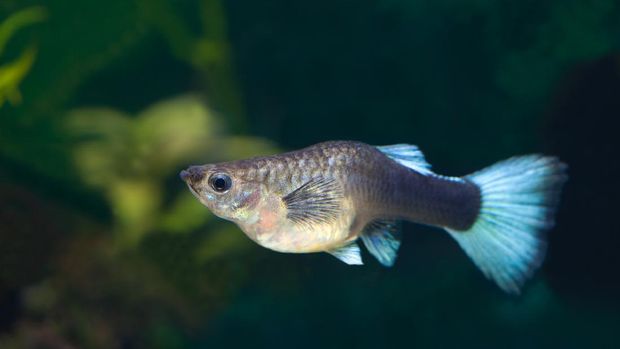
Rendering to the breeding and birthing requirements given, you can take the following essential steps to help a Guppy who is giving birth and to ensure the survival of the fry.
- Ensure that your pregnant female is removed from the communal tank after she shows signs of pregnancy, or around two weeks into her pregnancy, sooner is always better.
- Place the properly set up breeding tank in a quieter and more secluded place in your home away from noise and disturbances.
- The breeding tank will need to be cycled more regularly to keep the water optimally clean and keep to the proper water parameters.
- Feed your female guppy a protein-rich diet consisting of brine shrimp, insect larvae, and blood worms. Rather avoid egg yolk and minced beef as they quickly dirty the water. Feed her more regularly in smaller amounts that she can easily finish.
- Ensure that there are some hiding places such as plants or caves for the pregnant female to give birth without any stress.
Afterbirth Care
From what is learnt so far, it is obvious that the mother Guppy will be completely exhausted after pregnancy and birthing, so it would be ideal to give her a separate tank to relax and recuperate in for a week or two before introducing her back into the communal aquarium.
Guppies do not make the best mothers and will revert to eating their young, they cannot be left in the breeding tank with their fry. Moving the new mother Guppy may cause some stress, so ensure that the water parameters are similar to that of the breeding tank at first, and gradually decrease the temperatures to that of the communal tank.
Caring For The Fry
After removing the female Guppy from the breeding tank, the fry will need a clean tank with regular water changes, and constant temperatures of around 78 degrees F (25.5 degrees C.) until they are fully grown.
You can siphon water from the bottom of the tank, and replace it with new conditioned, and properly heated water every three days or so. Feed your Guppy fry baby brine shrimp, micro worms, and powdered flakes in small amounts at first, and at a later stage, more variety can be given. Once mature you can move the fry to their new home.
Final Thoughts
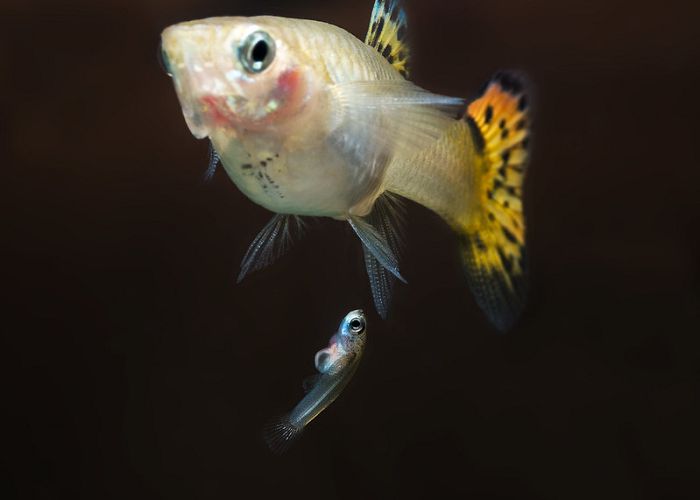
In conclusion, Guppies are quite easy and eager to breed. It can be a rewarding and fascinating endeavor regarding the different types and color variations of Guppies, to perform selective breeding. Nevertheless, as noted in the female Guppy, giving live birth takes much strain, and in many cases does not survive the birth. In this case, she must be given proper care to ensure her health and well-being, as well as that of her fry.


